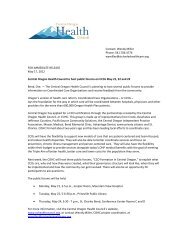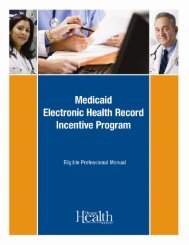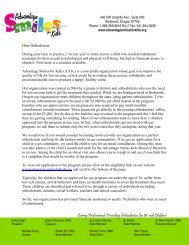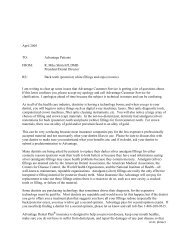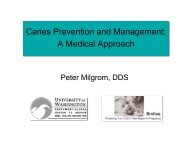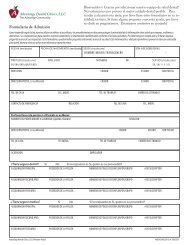Early Childhood Caries Prevention Protocol - Advantage Dental
Early Childhood Caries Prevention Protocol - Advantage Dental
Early Childhood Caries Prevention Protocol - Advantage Dental
Create successful ePaper yourself
Turn your PDF publications into a flip-book with our unique Google optimized e-Paper software.
<strong>Early</strong> <strong>Childhood</strong> <strong>Caries</strong> <strong>Prevention</strong> <strong>Protocol</strong>e <strong>Advantage</strong> Communityntage <strong>Dental</strong> Plan®hwest <strong>Dental</strong> Services, LLCwest Professional Management, Inc.roperty Management, LLCge Smiles for KidsA dental guide for treating Pregnant WomenPregnant mothers on Medicaid are almost 100% at-risk of transmitting dental disease to their babies.Understanding how the process works and taking simple steps can result in two-year-oldswith no tooth decay. See the back of this sheet for specific instructions on how to reduce decay.How is Tooth Decay Transferred?Strep MutansMutans StreptococciOne of the major bacteria that cause tooth decayis called Strep Mutans. Everyone has this bacteria intheir mouth. This bacteria grows and duplicateswhen sugar is present.ColonizationThe bacteria forms a bioflim called plaque and cancreate an acid that dissolves the supporting organicmaterial, allowing the enamel crystal to collapse whichcauses cavities.The strep mutan is transferred from primary care giver(usually the mother) to the child through contact withsalivia, etc.Transfer throughsalivia contactIf this oral infection is transmitted to the babywhile the baby’s own immune system is beingdeveloped (within the first six months) the baby’simmune system may recognize this high count ofbacteria as normal and not build defenses tofight the bacteria.<strong>Dental</strong> <strong>Caries</strong>in a babyIf the baby’s immune system doesn’t fight off thebacteria it may cause rampant decay of the teeth,which can result in hospitalization, unnecessary costsand may cause the child to fear future visits tothe dentist.
<strong>Early</strong> <strong>Childhood</strong> <strong>Caries</strong> <strong>Prevention</strong> <strong>Protocol</strong>A dental guide for treating Pregnant WomenNorthwest <strong>Dental</strong> Services, LLC protocol for early childhood caries.How can moms stop the cycle of tooth decay?The pregnant mom needs to visit the dentist after thefirst trimester and the dental hygienist to get her teethcleaned, her infection eliminated and her strep mutancount low before delivery.Lower Strep Mutan CountChlorihexidine mouth rinse is prescribed by thedentist for the mother to use during her last monthof pregnancy. She is to rinse twice a day for two weeksto reduce the strep mutan level.Chew Xylitol GumFollowing delivery, the mom will chew two piecesof xylitol gym, three times a day for six months. (seexylitol handout)Fluoride on four incisorsWhen the baby gets its first four incisors, between9 and 12 months, the baby and mother go to thedentist to have a fluoride varnish painted on the teeth.The baby goes every six months until they are twoyears old. If white spots appear on the teeth the babywill go more often for fluoride treatments.Pea-sized amount of fluoride toothpasteThe parent should also continue to brush the child’steeth with a pea-sized amount of toothpaste atbedtime -- spitting, not rinsing out.No tooth decay attwo-yearsBy this time, the baby will have all of its primary teethand their immune system will be developed to helpreduce tooth decay. Brushing daily will also reduce toothdecay.




